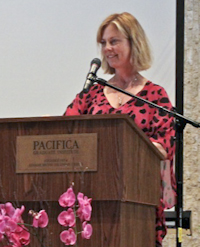
A Tribute to James Hillman
 “My loss when James died was like losing a great mentor. I imagine it to be the same for a lover of poetry, brought to tears when thinking of the death of a great poet that came before.”
“My loss when James died was like losing a great mentor. I imagine it to be the same for a lover of poetry, brought to tears when thinking of the death of a great poet that came before.”
photo • Kathee Miller
A Ph.D. in Mythological Studies (2011) from Pacifica Graduate Institute, Elizabeth Ann Robinson presented this reflection on 4 March 2012, at A Gathering to Offer Tribute and Celebrate the Life and Work of James Hillman.
≥ please listen @ https://soundcloud.com/pacificaalumni
•|•|•|•
After hearing Ginette Paris’ personal reflections about James Hillman’s death, I must start with the personal and then move to the symbolic.
I’m a nurse, and my work is about re-membering the soul of the nurse. Ginette shared a story about a nurse at the end of James’s life that is quite telling of a nurse who has lost her connection to soul, due in part to our fragmented and economic-focused healthcare system. My research reveals many shadow aspects of the nurse, and James claims the cure of the shadow is a problem of love (The Cure, 242). How far can our love extend to the broken and ruined parts? James maintains the human heart is the way to soul, and loving oneself is no easy matter because it means loving all of oneself and the care one gives this humiliating part is also the cure (Re-Visioning Psychology, 181).
For the nurse, I have to maintain faith that she can re-story her reality, collaborating with myths, fairy tales, fictions, even archeology, to re-vision her story into a more intelligent, imaginative plot, giving a sense of mythos along the way (Healing Fiction, 27). Since the soul is moved most profoundly by images that are disfigured, bizarre, or gross in fantasy life (Re-Visioning), what does it mean that a living nurse is drawn to a profession that is literally peculiar and requires work with the mess of woundedness? The professional nurse works daily with strangers and their mucous, blood, deep oozing wounds, stool, urine, pus, deformities, and a full range of emotions coming at her from every direction. She lives daily in the depths of mystery, ambiguity, uncertainty, and lack of clear answers. The nurse’s practice deepens into all of birth, life, death, tending toward valleys and unexplored pathways with tragic insight that knows about betrayals and suffering in life.
I know the archetype of the nurse has not disappeared — it has simply gone underground. James maintained that the best we can do is work more deeply within our own school, discover recesses that can be worked further, enriching our inheritance and deepening our loyalty (City & Soul, 100).
I didn’t know James personally. Yet I had to ask myself, “Why was I moved to tears upon hearing of his last hospitalization before he went home to die?” I discovered that my grief was around my worry that he have a good nurse. I was reassured at the time that Margo was an amazing advocate and would be sure he received the best care possible. That relieved me. Yet I did have this surprising concern, a strange feeling of connection: I wanted him to have the best kind of nurse to tend to his way of the dying process. I was saddened to hear that a hospice nurse preached to him the proper stages of dying, pushing drugs on him by twisting his word disgruntled into agitated because, in truth, she did not have the time or the consciousness or the medication for disgruntled. Now I know why I was worried.
This is why we cannot forget the literal. We have real bodies and body parts, and we need real nurses. The nurse is not only an abstract idea. She is also of flesh and blood, and works in the realities of matter and with those most vulnerable and often abandoned (Loose Ends, 37). In fact, she is not concerned with the idea of life but the fact of life.
Our nurses are losing their soul, and in my mind the nurse is our only hope for bringing soul into healthcare — if she can re-member her own authentic origins and make the move out of the Apollonian ethos. I suspect Margo was James’ true nurse all the way to the end.
Now, I’d like to make a move to the more symbolic — or, better, the embodied imagination. Hillman makes me think. He liked people to think. The kind of thinking James makes me do is a whole-body experience. For me, his material makes my skin crawl, my heart pound, my eyes blur, and my palms sweat. I have learned these uncomfortable sensations mean that connections are being made below my conscious awareness. The process is not fun. I want to run away, but I can’t. For me, there is no escaping James Hillman.
In April 2010, I attended the Puer and Senex conference. He spent the entire last morning talking about the nurse. The image James brought up was “The Roman Charity”: a nurse breastfeeding an old dying man.
This image goes back to before the Common Era and continues to show up today, as in the last scene of John Steinbeck’s The Grapes of Wrath. James explained that it is an absolutely archetypally accurate image, that this was the correct role for the nurse because in this image she ensures the future of the old man’s soul. The women in the audience were furious yet had difficulty saying exactly why. I mean, this is symbolic not literal, right? It was a lively several hours with complexes flying — a typical day with James. The image made me uncomfortable and I tried to move on, however the archetype grabbed me and would not let go. This is what James has tried to teach us: an archetype cannot be explained; it can only be experienced.
What was missing was the female nurse’s perspective. I realized it was not James’s responsibility to tell the female side of understanding; it is the responsibility of women, who experience phenomena from a female body. “The Roman Charity” image is not simply a pious act of obligation to feed someone in need, nor is it a pornographic distortion where the woman’s body is for the use of men. We see in the image that the nurse is a Dionysian maenad, and by letting her milk down she lets go of civilizing aspects, deepening her connection with nature. We as a culture tend to deny the animal parts of ourselves. Dionysian consciousness comes out of ambiguity where compulsion and inhibition belong together (The Myth of Analysis, 275). Dionysus responds to necessity, and in this image we see the nurse responding to the dying old man, tending his soul. Dionysus also demands complete sacrifice and surrender, and we see this not only in the nurse’s gesture but also in the old man sacrificing himself and surrendering: he is not pushing; he is soft, and has given over to his vulnerability; and he is receiving. The image represents mutuality, reciprocity, and eros. It is an act of choice for the nurse to give of her body to another body, yet the stimulus is instinctual.
I heard another anecdote yesterday that in the last days of James’s life he said something along the lines of, “I’m just an ignorant old fool terribly in love with my wife.” James maintained that the nurse in “The Roman Charity” represents the independence of the soul from the ego, and that her milk expresses the dependency of the ego on the anima for its life. He also claimed that the prerequisite of renewal is acceptance of dependency and need (Senex & Puer, 39-41). Perhaps this is why “The Roman Charity” holds such a healing image of renewal: the nurse is holding and tending the soul of the old man so it can go on; the old dying man accepts his dependency and need, and surrenders his patriarchal power to the nurse.
My loss when James died was like losing a great mentor. I imagine it to be the same for a lover of poetry brought to tears when thinking of the death of a great poet that came before. James Hillman challenged me in an entirely new way, grabbed me with the experience of archetype, shifted my assumptions and perspectives, and he lives on in my psyche and will influence my work the rest of my life.





